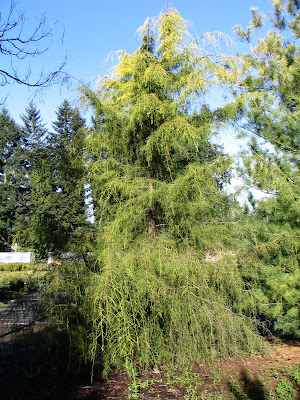As some of you know plant names always seem to be in a state of flux and this genus has been "revised". Lets hope the taxonomists don't get out of control but the genus is being "split" into new and old world cypress groups, and guess who gets the genus named Cupressus? Not us! They have been moved to a genus called Callitropsis. There is some hope that this will not be excepted using the conservation of names concept. Oops, new information, now called Hesperocyparis, meaning western cypress.
Anyway, while they do what they do, we can enjoy one of the most picturesque trees in our native landscapes. The monterey cypress is one of the few trees that can tolerate coastal winds, salt spray and cooler temperatures of summer. Too far from the coast they are susceptible to a fungal canker disease called Seiridium which is quickly fatal.
Further away from the coast, like all the way inland to Soquel Drive in Aptos they have the possibility of looking like this. Cupressus macrocarpa is a large tree reaching 70-80 feet away from the coast and often becomes more flat topped when mature.
Foliage of the cypress species are difficult to differentiate and require the use several features. One is the arrangement of the lateral branchlets on a young stem. They can be flat or rounded. These are in the rounded group, meaning that the smaller lateral branches come out on all sides of the branch.
Secondly, you will need to use a small hand lens to you look at the facial portion of the leaves, look for a gland. Presence or absence as well as being pitchy if there is one. These do not have a gland.
Leaves are scale like, small, 2mm in length, bright green but also dark green, fragrant when crushed and as you can see they radiate out from the stems.
The fruit are pretty distinct. They remind me of small soccer balls. The scales of the cones are peltate, they have a stalk on the back and are fused together along the margins and are not overlapping link seen in pine trees. The cones are green, turning brown, with 4-6 pairs of scales. Each scale has a small bump, but nothing like some of the other species. Individual cones are 1- 1.5" in diameter.
The bark and trunks are magnificent. I am not sure how they develop into the shape they are in, it seems that smaller branched are grafted to the main stem as they get larger and larger. Makes pruning large stems a problem (which is good really). Anyway, the trunks are very large in diameter and not at all round. They have persistent fibrous bark.
Monterey Cypress is a very fast growing tree. When young they are very upright with the main lateral branches arching up at about 45 degrees. These are a few young ones at Cabrillo.
It can also be grown as a hedge as seen here in Santa Cruz. Forgot the street name but I will stumble across it again. Its 221 Getchell St. Thanks to Peter Beckmann.
As I mentioned in RDM they were planted one per lot or sometimes 2. But they are dying and coming down due to a number of fungi and age. Here is the remainder of a trunk with the tree loggers left in for perspective.
You may encounter several cultivars of this species. This species is far more popular in New Zealand, where they have more than 25 named cultivars. Find a great conifer online store (Stanley and Sons) and look at the amazing selections.
One older one is called 'Lutea' and seen in reasonable frequency.
Another is an odd yellow one with branches very thin and few lateral branches creating a wispy droopy smaller tree. 'Saligna Aurea'. (Also known as 'Aurea Saligna')
Misidentification:
Just about any other Cupressus I am afraid. Use the gland on the leaves, the color, maybe the bark, the cones may help as the name suggests, large fruit, and the form. Not an easy one.
Also, this in one of the parents of xCupressocyparis leylandii.
Location: Everywhere, Point Lobos in Monterey is one of the best locations.
Aptos
Soquel Drive and State Park (cut down) but another just down the street.









